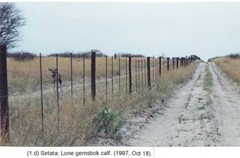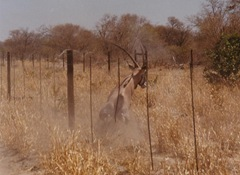We thought the battle had been won, but today we learn that it may just be beginning…
 In an effort to protect its cattle export industry from diseases contracted through wildlife contact, the country of Botswana has for many years, erected large scale veterinary fences. These fences, aimed at isolating cattle populations, are not only unsuccessful at preventing disease outbreaks from spreading, but are expensive to build and maintain, create social and economic challenges for the human communities of Ngamiland, and have fatal effects on wildlife (which can no longer access food and water sources). A government sponsored Environmental Impact Assessment, followed by a study commissioned by the Kalahari Conservation Society and funded by The WILD Foundation in 2005, successfully led to the decommissioning of the most controversial of these veterinary fences, the Setata fence.
In an effort to protect its cattle export industry from diseases contracted through wildlife contact, the country of Botswana has for many years, erected large scale veterinary fences. These fences, aimed at isolating cattle populations, are not only unsuccessful at preventing disease outbreaks from spreading, but are expensive to build and maintain, create social and economic challenges for the human communities of Ngamiland, and have fatal effects on wildlife (which can no longer access food and water sources). A government sponsored Environmental Impact Assessment, followed by a study commissioned by the Kalahari Conservation Society and funded by The WILD Foundation in 2005, successfully led to the decommissioning of the most controversial of these veterinary fences, the Setata fence.
 Unfortunately, after publicly acknowledging the wide range of negative impacts the Setata fence (shown in the photo on the right) was having, and removing it completely, the Government of Botswana is now actively working to re-instate this fence. The recent and shocking news of this unexplained reversal has prompted local and international organizations into action. Individuals and organizations are working to implement a plan of action in opposition to this new announcement. It is clear that re-instating the Setata fence will have very serious environmental, economic and social implications – not only for Ngamiland and Botswana, but also for the world community at large. The proximity of the proposed fence to the Okavango Delta, one of the world’s most diverse and magical places (a vast delta in the middle of the Kalahari Desert with no outlet too the sea!), threatens the wildlife ecosystem of this proposed World Heritage Site. WILD will post information on the blog and website on this urgent issue as it becomes available. Stay tuned!
Unfortunately, after publicly acknowledging the wide range of negative impacts the Setata fence (shown in the photo on the right) was having, and removing it completely, the Government of Botswana is now actively working to re-instate this fence. The recent and shocking news of this unexplained reversal has prompted local and international organizations into action. Individuals and organizations are working to implement a plan of action in opposition to this new announcement. It is clear that re-instating the Setata fence will have very serious environmental, economic and social implications – not only for Ngamiland and Botswana, but also for the world community at large. The proximity of the proposed fence to the Okavango Delta, one of the world’s most diverse and magical places (a vast delta in the middle of the Kalahari Desert with no outlet too the sea!), threatens the wildlife ecosystem of this proposed World Heritage Site. WILD will post information on the blog and website on this urgent issue as it becomes available. Stay tuned!

I just read about the idea of a bio-barrier, being researched with wild dogs in Africa. this is very interesting research that could help eliminate the need for fence barriers! https://ecoworldly.com/2009/04/20/microsoft-co-founder-funds-development-of-a-bio-barrier-to-protect-the-endangered-african-wild-dog/